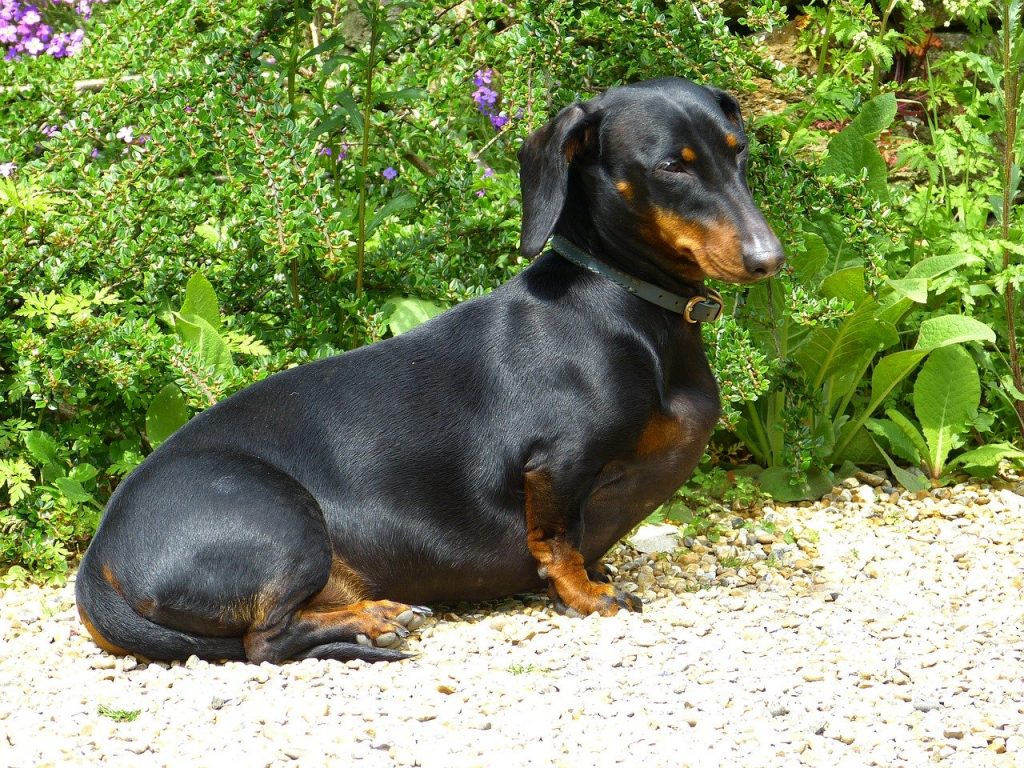Overview
Group: Hound Group
AKC Breed Popularity Rank: No. 12 of 195
Height: Standard – 8-9 inches; Miniature – 5-6 inches
Weight: Standard – 16-32 lbs; Miniature – 11 lbs and under
Life Span: 12-16 years
Temperament: Friendly; Exuberant; Curious
Next to the Bulldog, the Dachshund is another breed that does not require a lengthy introduction. No one could ever mistake the Dachshund for another breed. Because of its low, long body and short, stubby legs, it has come to be affectionately known as the “Weiner Dog.”
History
The American Kennel Club dubbed the Dachshund as the “icon of purebred dogdom” and with good reason. Developed 600 years ago in Germany, the Dachshund was developed by German breeders without crossbreeding with other types of dogs.
The result is a dog with a low, long body, stubby legs, and broad paws which are very effective for digging underground. While the dog has been used for the purpose of digging for wild rodents, its most formidable opponent is the badger, which can be very vicious when attacked. However, the dog has proved more than capable against the badger. For this reason, this breed has come to be known as “Dachshund” or “badger dog”. Dachshunds have also proven worthy in wild boar hunts.
Because of his sausage-shaped body, the Dachshund has come to be known as the “weiner” or “sausage” dog. Dachshunds have been the subject of numerous arts by Picasso and Andy Warhol.
General Appearance
You cannot mistake the Dachshund for any other breed because of its characteristic long, low, and muscular body, and short stubby legs with broad feet. It has medium-sized, almond-shaped eyes that evoke a pleasant and playful expression.
There are three types of Dachshunds depending upon its coat type, namely smooth, wirehaired, and longhaired. Smooth Dachshunds have short, smooth, and shiny coats. Wirehaired Dachshunds have a thick, rough, coarse upper coat with a shorter and softer undercoat. In addition, wirehaired dogs have eyebrows and a beard. Longhaired Dachshunds have a long, sleek and wavy coat.
Dachshunds, in general, are friendly, cheerful, and loving. They are also smart and curious by nature. While they love to play with their human family, they are equally protective of them, so that they make for excellent watchdogs.
Nutrition
When feeding your dog, Dachshund puppies should be given moist food four times a day. Once they reach three months of age, they can be switched to dry kibble, given three times a day. Ask your veterinarian for the best dog food that is appropriate to its age.
However, the one nutrition rule that you should follow is that you should never let your Dachshund get overweight. The excess weight can lead to serious strain in the dog’s back, which can result in slipped or herniated discs. Only give the recommended amounts. Treats should also be measured.
Grooming
In general, Dachshunds are moderate shedders, but their grooming depends upon the type of their coat. Smooth Dachshunds will only require the use of a hound glove to get rid of dead/loose hair or a quick wipe down with a towel when dirty. Wirehaired Dachshunds need to be plucked or hand-stripped yearly to keep its coat looking beautiful. It is sufficient to brush or comb them once or twice a week. Just make sure that you trim their eyebrows and beard regularly. Longhaired Dachshunds need to be brushed more frequently to keep its coat wavy and shiny, and to prevent matting.
Exercise
Dachshunds need lots of exercise and mental stimulation in order to maintain its cheerful disposition. Exercise is also important to strengthen the dog’s back muscles. Ideally, you should walk your dog for 30 minutes twice a day. Never allow your dog to jump on/off furniture or run up/down your stairs to prevent injuries.
Training
Despite their intelligence, Dachshunds are challenging to train because of their short attention spans. For this reason, training sessions should be kept short at just five minutes, two to three times daily. They do not respond well to punishment, so it is best to keep training fun, positive, and reward-based. Make sure that you shower your dog with praise and affection if they performed a task well or if they obeyed your command. Potty training your Dachshund is an exercise in patience and consistency as well. Ideally, you should train your Dachshund to poop outside the house by designating a specific spot for that purpose.
Health
While Dachshunds are generally healthy, sturdy dogs, you should take extra care of its back by watching its diet and weight and making sure that it doesn’t jump to and from high places to prevent injuries. In addition, since the Dachshunds have drop ears, always clean their ears regularly and watch out for any signs of infection.
Costs
The average cost of a Dachshund puppy is $600. But you can expect the price to go up by as much as $1,600 to $5,500 for championship line puppies. Thankfully, they are an inexpensive breed, so grooming and maintenance costs are relatively low. Again, what you should watch out for are back problems in your dog. Treatments for back problems in Dachshunds may go as high as $7,300.
If you are up to the challenge of training, a Dachshund is a worthwhile dog to own because of its cheerful, affectionate nature, and watch dog temperament. Not to mention the fact that it is an absolutely cute sausage dog!
SOURCES:
1) Dachshund https://www.akc.org/dog-breeds/dachshund/
2) How to Determine a Dachshund’s Ideal Body Weight
https://www.petcarerx.com/article/how-to-determine-a-dachshunds-ideal-body-weight/306
3) Training Dachshunds https://www.wikihow.com/Train-Dachshunds
4) Train a Dachshund to Potty Outside https://wagwalking.com/training/train-a-dachshund-puppy-to-potty-outside
5) Dachshund Puppies for Sale https://www.nextdaypets.com/Dachshund.htm
6) Cheapest Dog Breeds https://www.gobankingrates.com/saving-money/pets/cheapest-dog-breeds/


